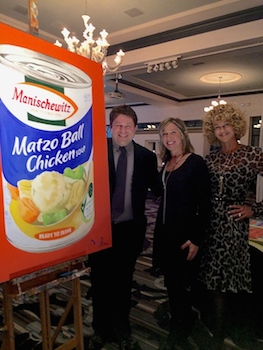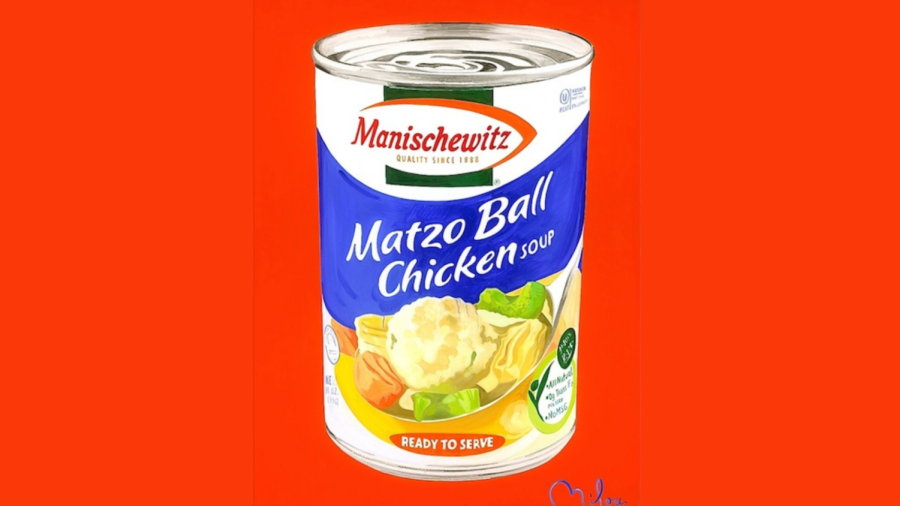Warhol never did Manischewitz
Jordan Palmer, Chief Digital Content Officer
Published March 14, 2022
I am watching the new Netflix documentary “The Andy Warhol Diaries,” and it’s really good. I’m relearning several things, such as his influence on trendy pop art. How his Marilyn Monroe images are iconic. That he created many portraits, including a series titled “Ten Portraits of Jews of the Twentieth Century.”
And of course, more about his Campbell’s soup cans, which brought the advertising and art worlds together. How he took a simple can of food and turned it into something quintessential.
As I watched, I realized something. Warhol never did Manischewitz.
But artist Perry Milou did, and the story about how this work of pop art came to be is fascinating.
Warhol never did Manischewitz
Growing up in Philadelphia, Milou’s father found success in the restaurant business and passed on his love for food and all things Italian to his son.
“I learned early on that I had a talent for art, and love for pop art, so when I started to really look at cans from the Cento Company which is based nearby, I was inspired by my love of boldly colored graphic art, admiration of Andy Warhol’s classic images and pride in my Italian heritage,” said Milou.
In 2014, Milou, 53, began a series of paintings entitled, “Warhol Never Did” featuring cans from the Cento Fine Foods line.
“I started really looking hard at the stacks of Centro Brand Products stacked in my pantry. The packageing is bold, graphic design,” said Milou. “I could not resist but to start a Pop Art series featuring a collection of paintings of Cento and other pantry style food products created in a bold Warholian style; a homage to my favorite food and one of my favorite artists.”
After using social media to do some guerilla marketing, Cento Vice President and marketing guru Maurice Christino reached out to Milou after viewing an early tomato piece called “Crushed Cento” on Instagram. The result was an incredible tour of the Cento Empire, and a commission to paint Cento’s world-famous San Marzano’s tomatoes for their corporate headquarters.
Rabbi’s request for Manischewitz
After Milou’s Cento paintings began to be seen publicly, he received a call from a good friend and spiritual mentor Rabbi Yudy Shemtov from Lubavitch of Bucks County, Pa. Yudy wanted Milou’s help to support a fabulous cause at The 2nd Annual Bubby’s Cook-off.
“When asked to participate in Lubavitch of Bucks County Bubby’s Cook-Off, I was excited to produce something from my Jewish heritage,” said Milou. “I painted this Warholian-style Pop oil painting honoring iconic kosher foods mogul Manischewitz. The flat orange background is bold and really pops the graphic design of the classic soup can design.”
In creating a Warhol look, Milou painted the background super flat with four coats of bright orange semigloss. The matzoh balls are the key ingredient in this famous soup, so their puffiness is rendered very tightly, yet lightly.
Milou’s painting is titled “Jewish Penicillin” because it is said that the schmaltz (or rendered chicken fat) is what really helps to clear your sinuses and sore throats when you have the flu.
The painting, 48/36 inches/oil on canvas, sold at night’s end to local super auctioneer Steven Katz.

Own your own Manischewitz
While the original painting is long sold, Milou does offer four Giclee sizes:
15″ X 20″ – $ 125.00
22″ X 30″ – $ 295.00
30″ X 40″ – $ 595.00
36″ X 48″ – $ 795.00
What Is Giclee?
Pronounced ‘jee-clay’ a French term describing the process in which pigmented inks are applied to reproduce a fine art reproduction. Highly trained technicians spend countless hours in spectrophotometry, matching color hues and textural effects of original pieces of art. Using high-resolution digital photography and scanning equipment exceeding tens of thousands of dollars, a fine art reproduction is then created picking up every nuance of the original painting.
















